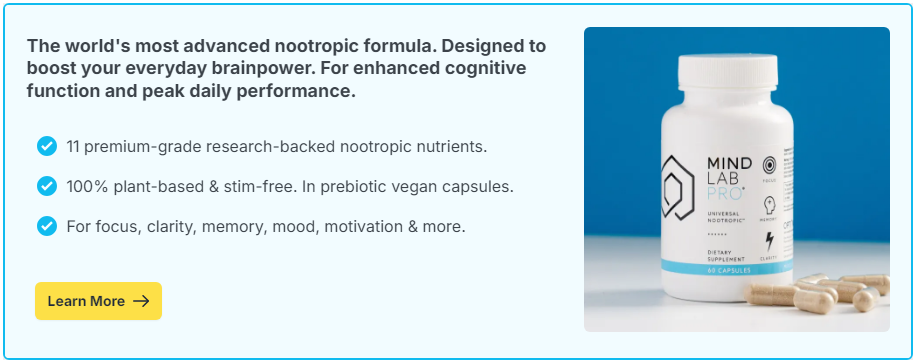
The baby finally sleeps, your alarm also known as a human squeak toy goes off, and your thoughts feel like socks from the dryer, paired poorly and slightly warm. Early parenthood is joyful and chaotic, with sleep that arrives in snack sized portions. Clear thinking is still possible. With a simple morning routine, sensible stimulant rules, and a careful toolkit that supports attention without adding stress, you can get through emails, appointments, and basic adulting while keeping energy steady.
Contents
The Morning After Sleep Debt, What Your Brain Is Up Against
Short nights change how thinking feels. Sleep debt raises sleep pressure and slows reaction time. Cortisol tends to peak earlier in the morning, which can help alertness a little, yet sleep inertia the heavy fog after waking can still hang around for thirty to ninety minutes. Add interrupted sleep cycles from overnight feeds and diapers, and you meet a special kind of mental static. None of this means you cannot function. It does mean you need tactics that respect biology.
Think of attention like a rechargeable battery. After a choppy night, you wake at fifty percent, not one hundred. The goal is to spend that charge on the right tasks, then plug in frequent micro recharges. Light is the first charger. Bright, indirect morning light is a strong alertness cue. Step near a window for two minutes, or open the door while the kettle heats. If weather allows, a brief step outside helps even more. Pair light with water. Hydration falls overnight, especially if you sweat, feed, or breathe through your mouth. A large glass first thing can lift energy surprisingly well.
Fuel matters too. Heavy breakfasts make eyelids heavy. Too little food leaves you edgy. Target protein plus slow carbs plus color. Examples include eggs with a small tortilla and avocado, Greek yogurt with berries and oats, or oatmeal with chia and peanut butter. If mornings are chaos, create a shelf of ready items that require zero thought, portioned yogurt cups, precooked eggs, overnight oats, or smoothie packs in the freezer. A prebuilt choice is a gift to your future self at 6 a.m.
Your working memory, the mental scratchpad for steps and names, is the first casualty of sleep loss. Fight back with external supports. Use a single visible list on the fridge or on your phone’s home screen with three boxes, must do today, nice to do, and can wait. When the inevitable interruption appears, you will land back in the right spot without spending brain cycles on where was I. Attention saved is energy earned.
A Plug and Play Morning Routine That Survives Baby Schedules
Routines save thinking for things that matter. This plug and play sequence is built for mornings when hands are full and time is flexible. Run it in order, pause when you must, and resume at the next step without guilt.
- Step 1, Light plus water: blinds up or door cracked open, drink a full glass. If you wear glasses, clean them now so your visual field feels crisp. Tiny detail, big difference.
- Step 2, Ten minute reset: a quick tidy of the main surface you use, sink, counter, or desk. Cleaning three square feet reduces visual noise and makes the next action obvious.
- Step 3, Protein first: grab a prebuilt breakfast. If a full meal is not possible, go for a protein heavy snack and fruit while you prep bottles or breakfasts for others.
- Step 4, Two minute movement: calf raises while the coffee brews, a short hallway walk while rocking the stroller, or ten air squats with the baby carrier safely secured. Movement lifts mood and fights inertia.
- Step 5, Three box plan: write or speak into your phone the must do, nice to do, and can wait items. Limit the must do list to two or three. Overstuffing lists creates stress, not progress.
Build a tiny toolkit in one basket so you are never hunting. Include a water bottle, a phone stand for hands free calls, a few protein bars you actually like, earplugs for a brief quiet minute, and a pen with sticky notes. Place the basket in the room you use most in the morning. You will be amazed how much friction disappears when your tools do not migrate around the house.
Schedule your brain work near natural peaks. Many new parents feel the clearest in the first ninety minutes after waking once the initial fog lifts with light, water, and food. Put admin tasks here, booking appointments, paying bills, or writing the single important email. Place lower stakes chores during the late morning dip, folding laundry, cleaning bottles, or a quick grocery order. If you can tag team with a partner, consider alternating twenty minute focus slots while the other is on baby duty. Set a simple timer and switch. Clear handoffs prevent resentment and keep the day moving.
Finally, plan the night support during the morning. Lay out pajamas for the baby, pre stage the diaper kit, refill the humidifier or sound machine, and place a clean water bottle by your bed. These small acts lower the chance of a midnight scavenger hunt, which protects what little sleep you will get.
Smart Caffeine Rules for Tired Parents, Calm Energy Over Jitters
Caffeine can be a helpful friend when used with care. The goal is stable focus, not a shaky sprint followed by a crash. Start with small, timed doses early in the morning, then pause. Many parents like pairing caffeine with L Theanine, an amino acid in tea that often smooths the edges and makes attention feel steady. If you drink coffee, try half a cup with breakfast, then sip tea later. If you prefer precise dosing, a small caffeine gum can help you avoid overshooting.
Set a hard cutoff early afternoon so sleep is not robbed later. Remember, your sleep window may arrive at odd hours, a daytime nap after a rough night or a surprise early bedtime. Caffeine still counts. Keeping it early lets you take advantage of any rest opportunity that appears. Combine beverages with bright light and movement before reaching for a second cup. A two minute step outside with three slow breaths can be just as energizing as another pour.
If you are pregnant or nursing, your situation deserves personalized guidance. Work with your clinician on caffeine limits that match your health, your baby’s needs, and your tolerance. Non caffeine strategies become even more valuable under those constraints, light, hydration, movement, and tight task lists. For many, these four together rival a second cup without the jitter factor.
Consider timing around feeds. If you tolerate caffeine, placing a small serving shortly after a feed may reduce the amount present by the next one. Again, follow your clinician’s advice. If you choose to use any supplement, do not introduce it for the first time on a high stress day. Test on a calm day first and keep notes about how you feel.
A Careful Nootropic Toolkit For New-Parent Focus
Nootropics can be part of a parent friendly plan when used thoughtfully. The emphasis is on low stimulation, clear attention, and steady mood. Always consult your clinician first if you are pregnant, nursing, taking medications, or managing a condition. Use the fewest ingredients needed for the role you want to fill, then track your response for two weeks before changing anything.
Calm Focus and Signal Clarity
- L Theanine: often paired with caffeine for smoother attention. Many parents like it on mornings with lots of reading, forms, or coordination, since it can make focus feel even rather than buzzy.
- Citicoline: commonly used for mental energy and sustained attention during complex admin tasks. Some place it at the start of a focused block while a partner covers baby duty.
Stress Windows and Stamina
- L Tyrosine: a precursor for dopamine and norepinephrine. People sometimes use it earlier in the day when pressure is high, like pediatrician scheduling, insurance calls, or a return to work meeting. Avoid stacking many energizing choices at once.
- Rhodiola Rosea: chosen by some for fatigue resistance during repetitive chores. If it feels energizing to you, place it early and avoid late day use so sleep has a fair chance.
Memory and Long Game Clarity
- Bacopa Monnieri: a longer horizon ingredient taken daily over weeks for learning and recall. Useful for remembering new routines, pediatric dosing instructions, or caregiver handoffs.
- Lion’s Mane Mushroom: widely used for general cognitive support. Many describe a clean clarity that suits writing, gentle planning, and problem solving.
Structural and Circulation Support
- Phosphatidylserine, PS: often included for attention and composure. Because it is not stimulating, some place it later in the morning or early afternoon to keep focus tidy while avoiding a wired feeling.
- Maritime Pine Bark Extract: valued for a fresh, clear feel. Many take it with the first water bottle to start the day on an even keel.
Pick one calm focus option and, if needed, one stress or long game option. More is not better. Combine with the routine and the stimulant rules above. If you are nursing or pregnant, get medical input first and prioritize non supplement tactics that carry no exposure risk.
Memory and Workflow Shortcuts For Foggy Mornings
Sleep loss shrinks working memory, so offload as much as possible. The goal is a house where decisions and details live outside your head.
- One board to rule them all: place a whiteboard or a large sticky sheet in the kitchen. Use three columns, today, this week, waiting on. Move items every morning. When your attention resets after an interruption, the board points you to the next step.
- The five minute basket: keep small tasks that take five minutes in one list, refill diapers in the living room, set out dog food, reply to the school form. When the baby naps, you knock out two or three and feel human again.
- Voice notes over perfection: use your phone’s voice note or a simple notes app. Speak a quick memory hook, medicine refill Friday, call Grandpa at lunch, send daycare code. Later, convert the list to the board.
- Templates for repeated messages: build three text or email templates, late arrival note, appointment reschedule, and thank you for help. Fill blanks and send. Less typing, less thinking, fewer errors.
- Two box email: create two folders, action and wait. If the reply will take more than two minutes, it goes to action. If you await a response, it goes to wait. This keeps the inbox from becoming a fog machine.
Protect attention by controlling your visual field. Clear the main counter at night so the morning starts clean. Put your phone face down and off the workspace. Keep only one tab group open on the computer. During feeds, keep a small stack of flashcards or a short reading list, one article tagged long read, one tagged fun. Pairing a necessary task with a tiny personal reward keeps morale from flatlining.
Communication with a partner or caregiver is a superpower. Use a daily two minute standup, in person or by text. Share the top two must do items each, the choke point for the day, and one help request. This tiny ritual removes guesswork and resentment. Everyone knows what matters and who needs backup.

